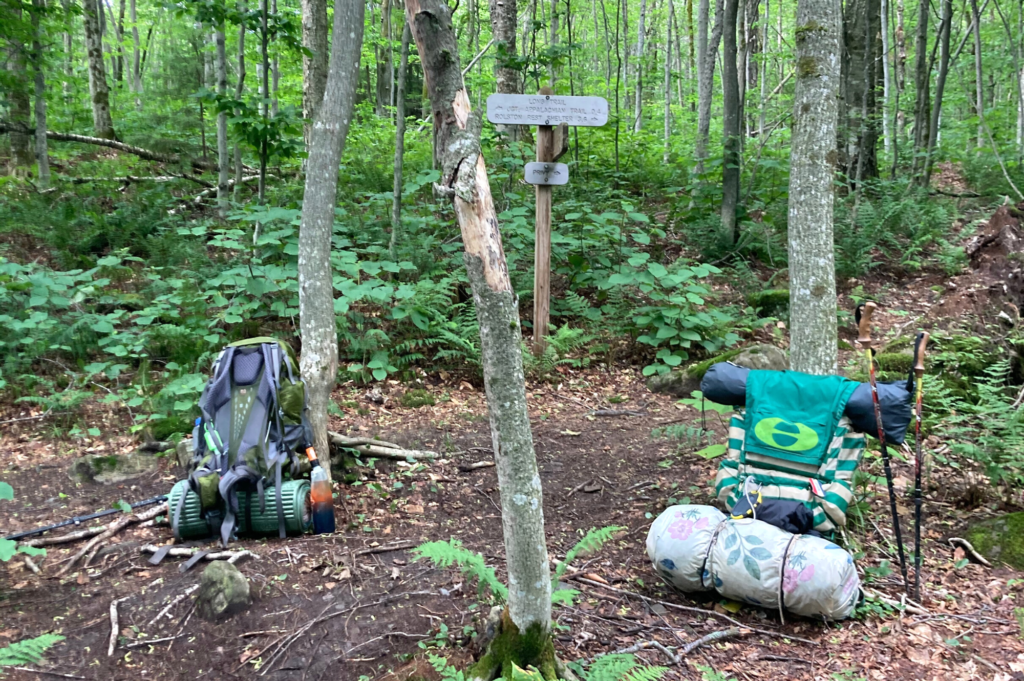
Interested in backpacking (or inspired by this year’s 481 End-to-Enders)? Getting started can be intimidating but once you get going, it’ll quickly become second nature. Here’s what you need to know about backpacking as you get started. Have questions? Email our experts or stop by the Marvin B. Gameroff Hiker Information Center in Waterbury.
Clothes & Gear
You don’t have to spend a ton of money, but quality gear that fits well will make a big difference in your comfort. Your pack should fit your body (try on several at an outdoor retailer) and hold all your gear (45-65 liter capacity). Pack strategically so the weight in your pack is distributed evenly and isn’t pulling on your shoulders or back. Weight should sit on your hips.
As for clothing, avoid cotton on all but the sunniest and driest of day-hikes. Beyond that, follow the WISE synonym, carrying at minimum:
- Wicking (quick-dry base layer)
- Insulating (warm mid-layer)
- Shell (water- and wind-proof outer layer)
- Extra (down jacket, hat, gloves, socks)
Wear sturdy hiking boots or shoes and feel confident in their fit before setting out on a full trip. Dry, wool socks are your best friend. Keep tabs on tender hotspots, which turn into blisters and can quickly ruin a hiking trip.
Backpacking 101: Get Started Outside
- Get comfortable day hiking with a backpack
- Build core strength to improve balance and handle a heavy pack
- Increase distance, pack weight, and challenge
- Do a one-night overnight in the backyard or a short hike distance to test gear and skills. Try one of these overnight hikes.
- Stay injury free with stretching, yoga, and strength training
Sleeping on Trail
There are lean-tos, shelters, and tent sites throughout the Long Trail System and New England. Use a guidebook and map to plan your overnight stopovers, and consider having a backup if you don’t hike as far as you expect. During peak summer and fall months, you’ll likely be sharing shelter space with others; tents provide privacy and are a good backup in case shelters are full.
You’ll also want a warm sleeping bag and a sleeping pad for both comfort and warmth. Don’t be surprised if it takes some practice to get used to the new environment and sleep soundly. Ear plugs can help.
Designated overnight sites also have a water source and privy. Specifics vary, so plan ahead using the guidebook and follow signage or caretaker direction at the site.
Wildlife & Food Storage
We’re guests in the woods, and animals like our food. If we don’t properly store it, we risk exposing them to our food which is harmful for both wildlife and humans.
Store food and all other smellables in a bear canister (the most foolproof method) or Ursack; use a GMC-provided bear box (at some shelters but not all), or throw a properly hung bear bag (nigh impossible at some LT overnight sites). You can borrow a bear canister from the GMC for free.
Backpacking Foods
As for what to eat, you can go as simple or as fancy with it as you want. Dehydrated or freeze-dried meals such as Backpackers Pantry or Good To-Go are quick and nutritious and require only boiling water. Find them at any outdoor retailer. With a little research and frontcountry preparation, you can also enjoy simple yet delicious made from scratch meals. Depending on the length of your trip, additions like preserved meat and cheese will up the satiety level and will last unrefrigerated for a few days. Carry plenty of calorie-dense snacks like protein bars, candy, jerky, and trail mix. Repackage food from original containers into Ziploc bags, which are lightweight, durable and packable.
Water Safety
You need a lot of water on a backpacking trip, both for drinking and cooking. You will find places to refill your water on the trail, but it needs to be treated to avoid infection and illness before using it for drinking or cooking. Use a Sawyer Squeeze or similar filter, iodine tablets, or boil water before drinking. It’s a good idea to always have a chemical backup in case your filter breaks or falls in a river. Look for clear, running water and fill up whenever you have the opportunity, as you don’t always know what the water source quality will be up ahead.
Backcountry Emergencies
You are responsible for being prepared for emergency situations. Some simple precautions can help empower you to address your situation when plans go awry. Attend a Wilderness First Aid Class, carry appropriate equipment and gear, and leave your itinerary with at least two reliable contacts.
The most common potential emergency situations are minor-to-moderate injuries, weather conditions, and finding yourself hiking in the dark unexpectedly. In the event of an emergency, stay calm, make a plan, and keep yourself safe. Cell phones or satellite beacons are good to have, but you should always have a backup in case your technology fails.
This article originally appeared in the Summer 2022 edition of the Long Trail News under the title “Backpacking 101.”



















Leave a Reply